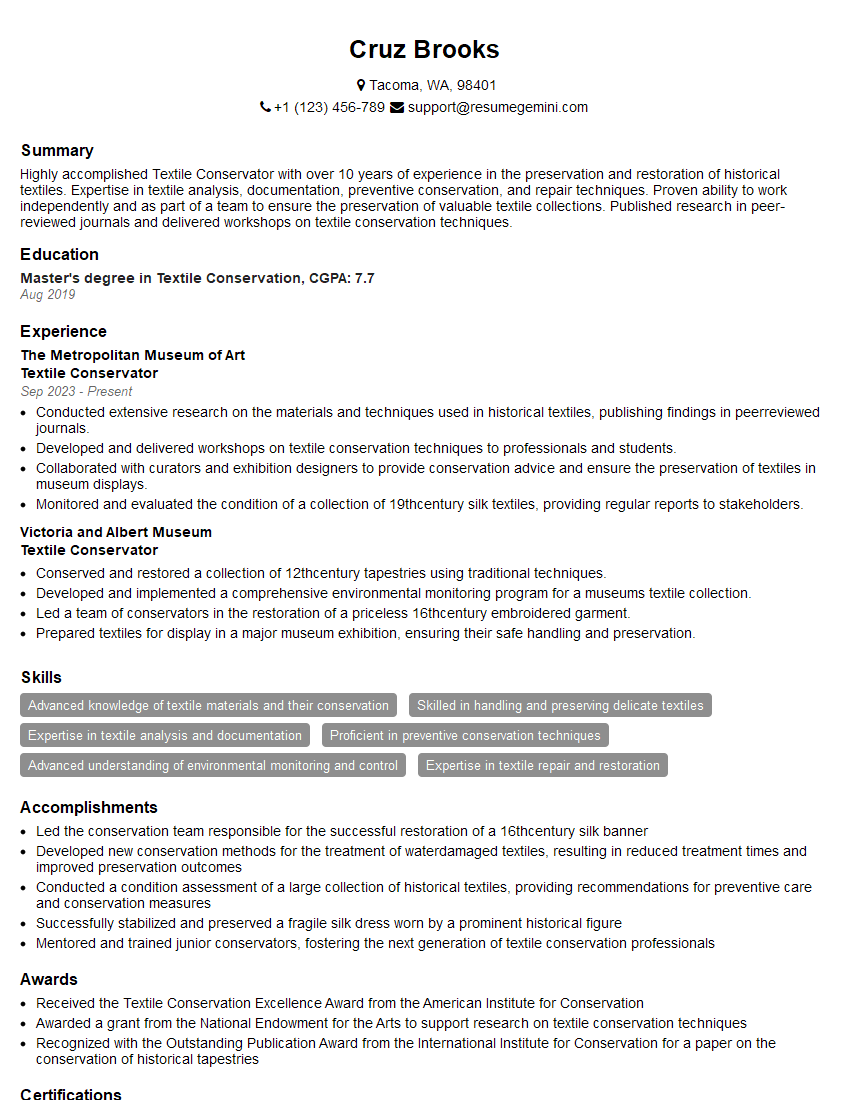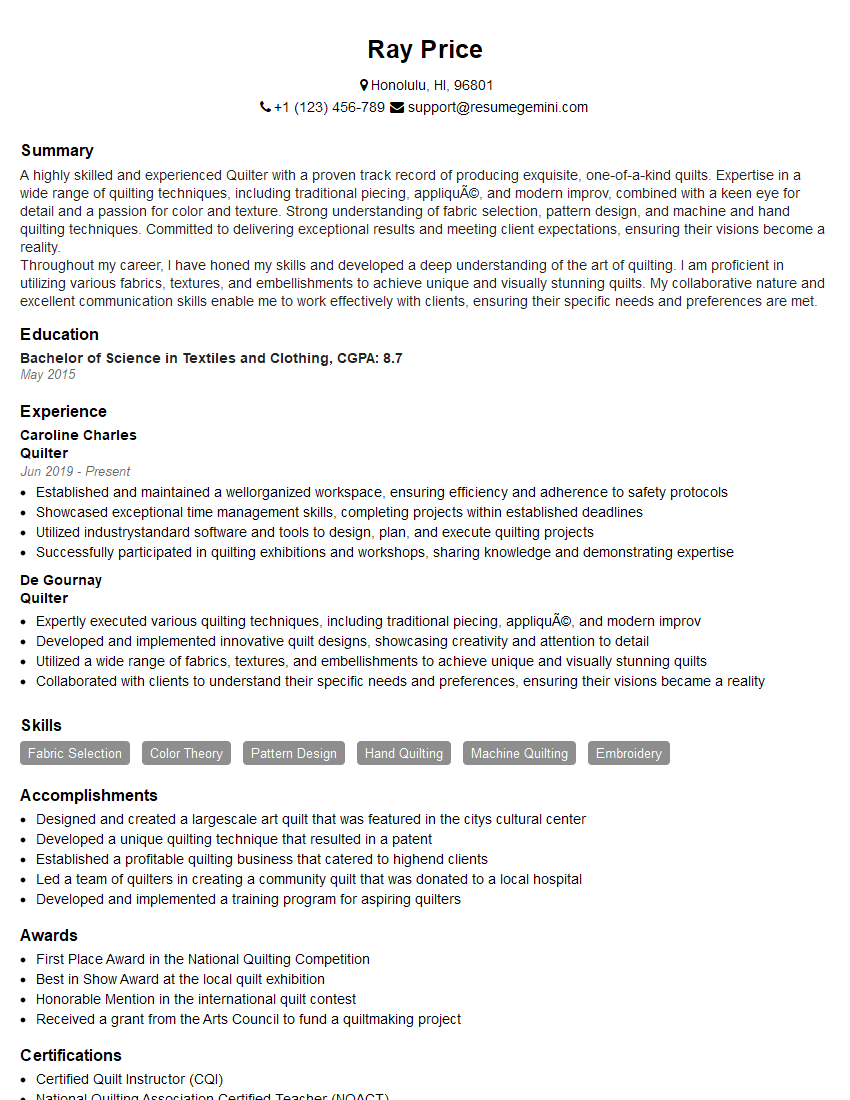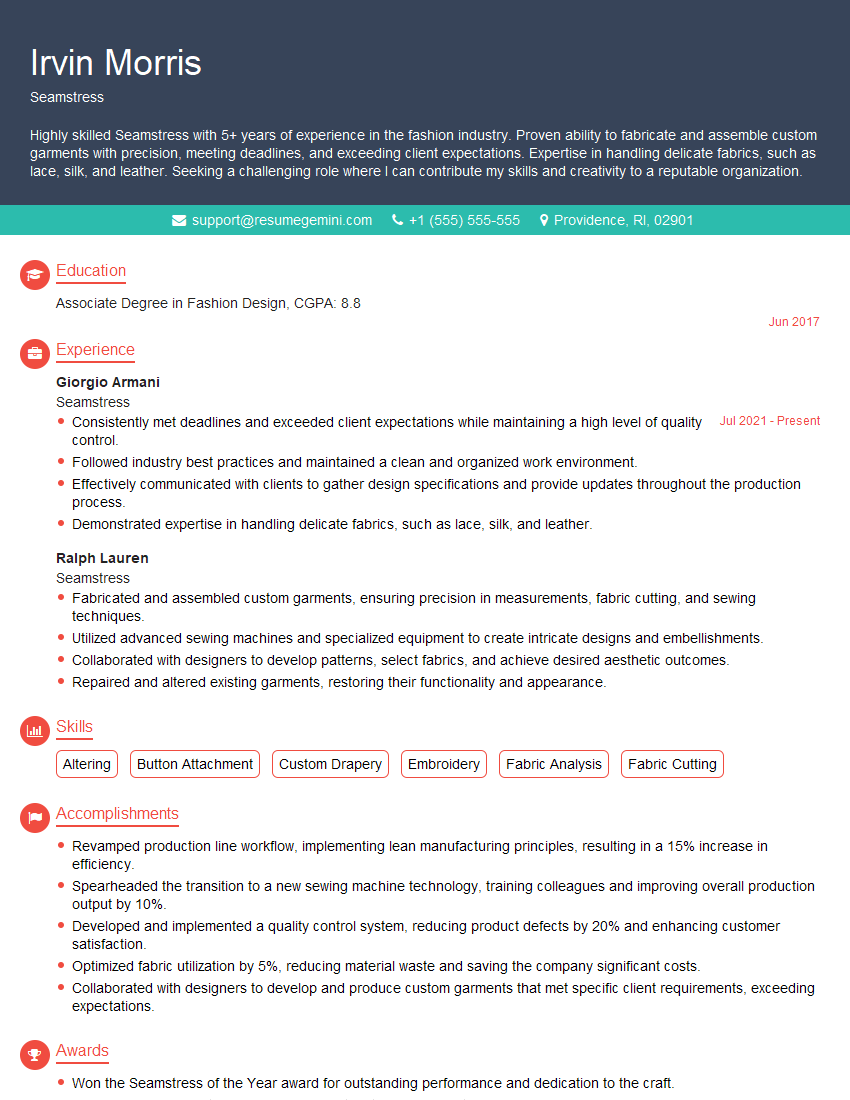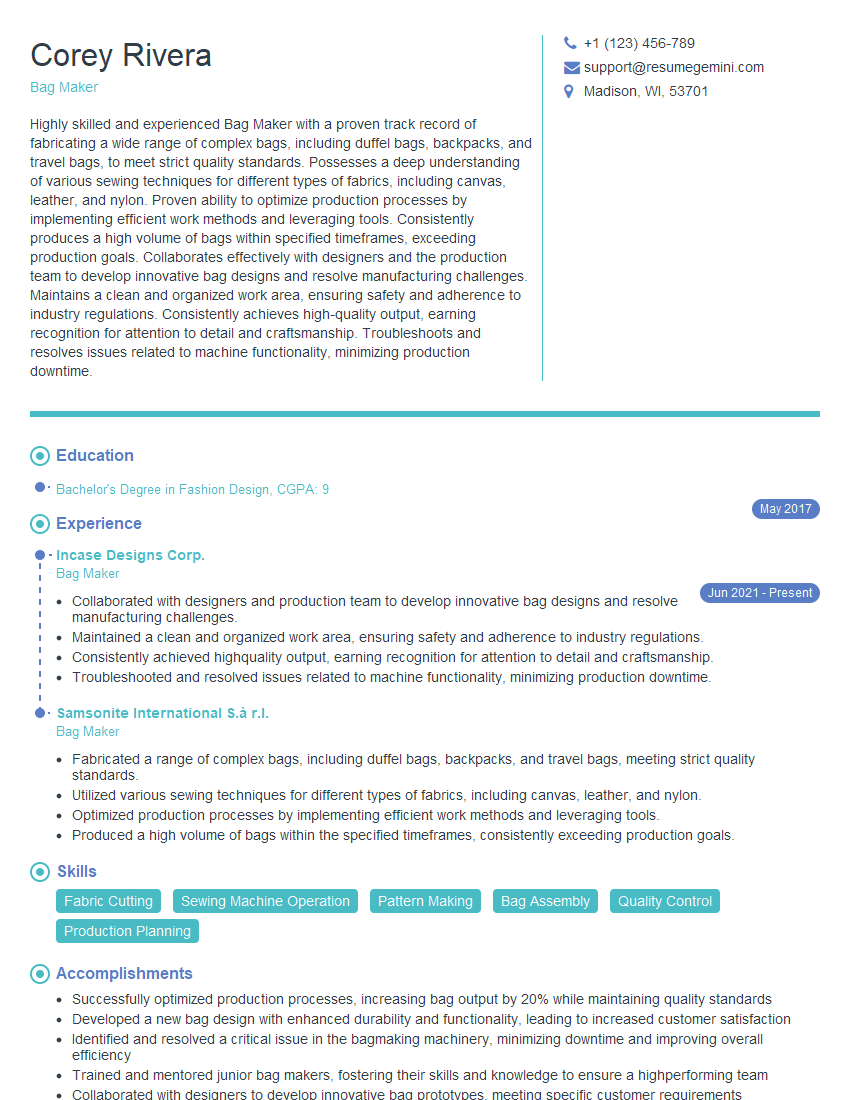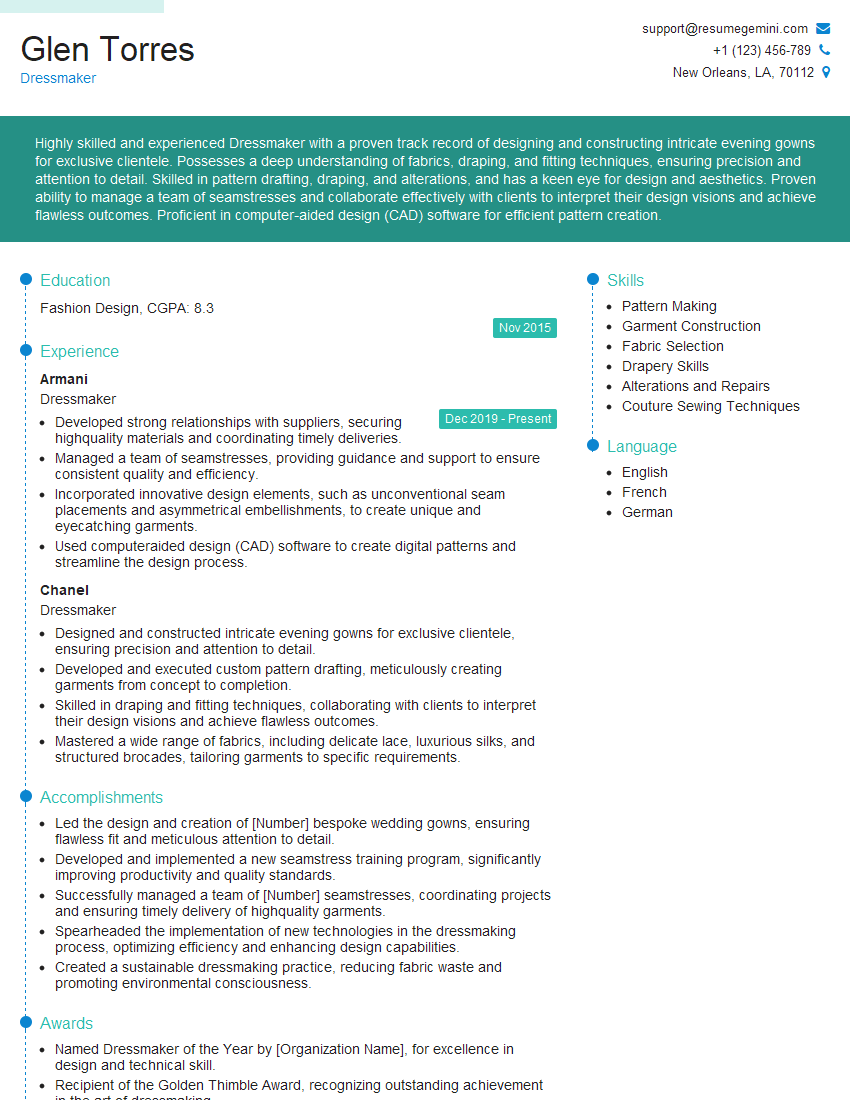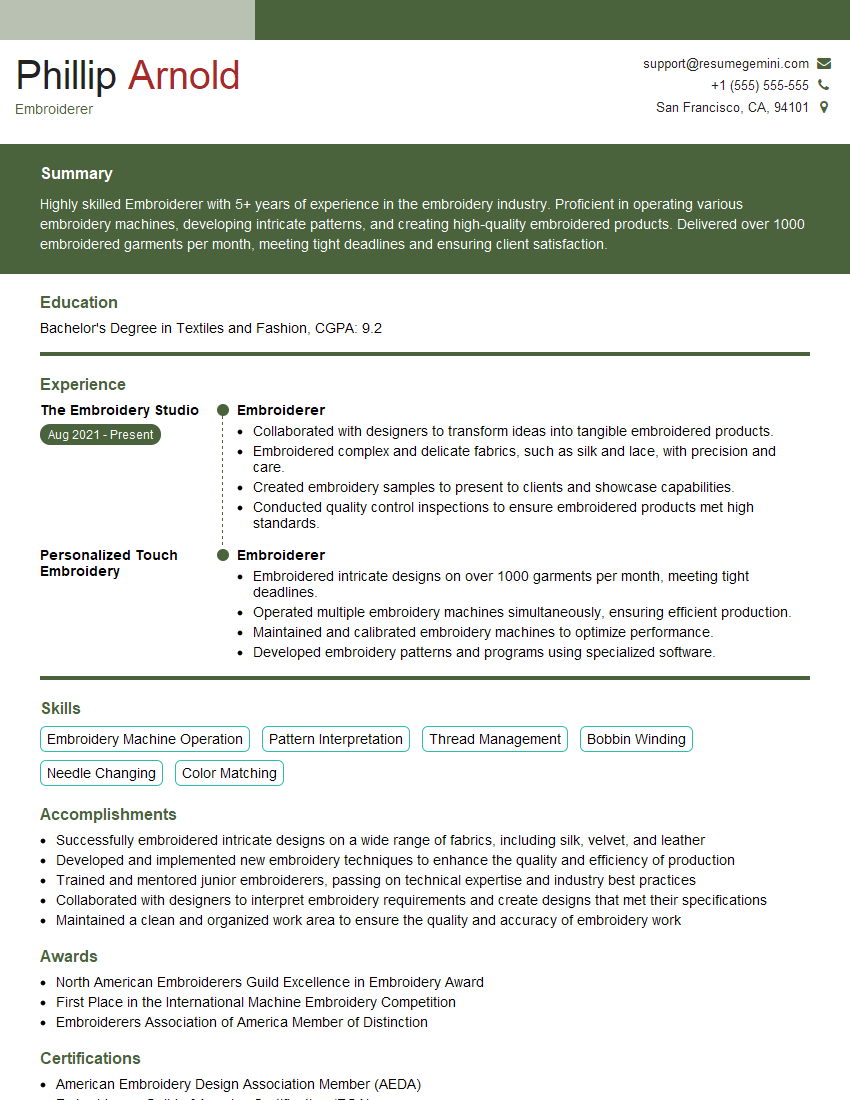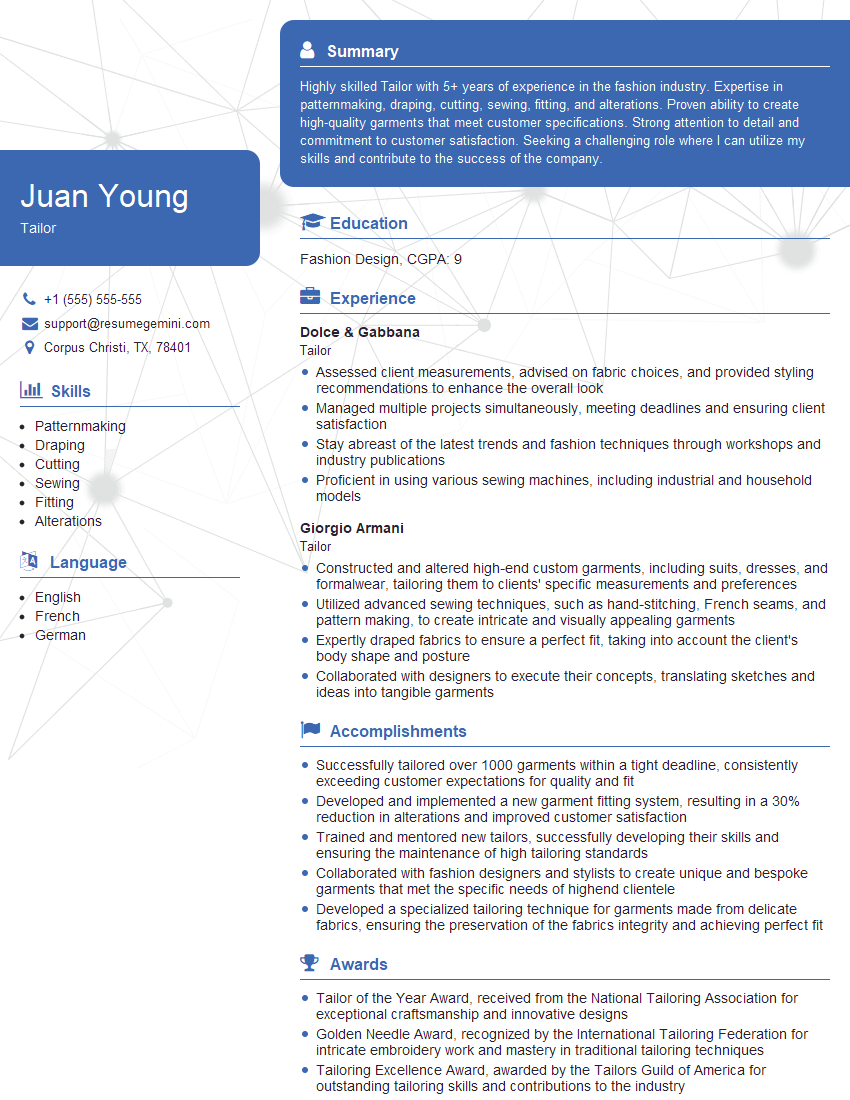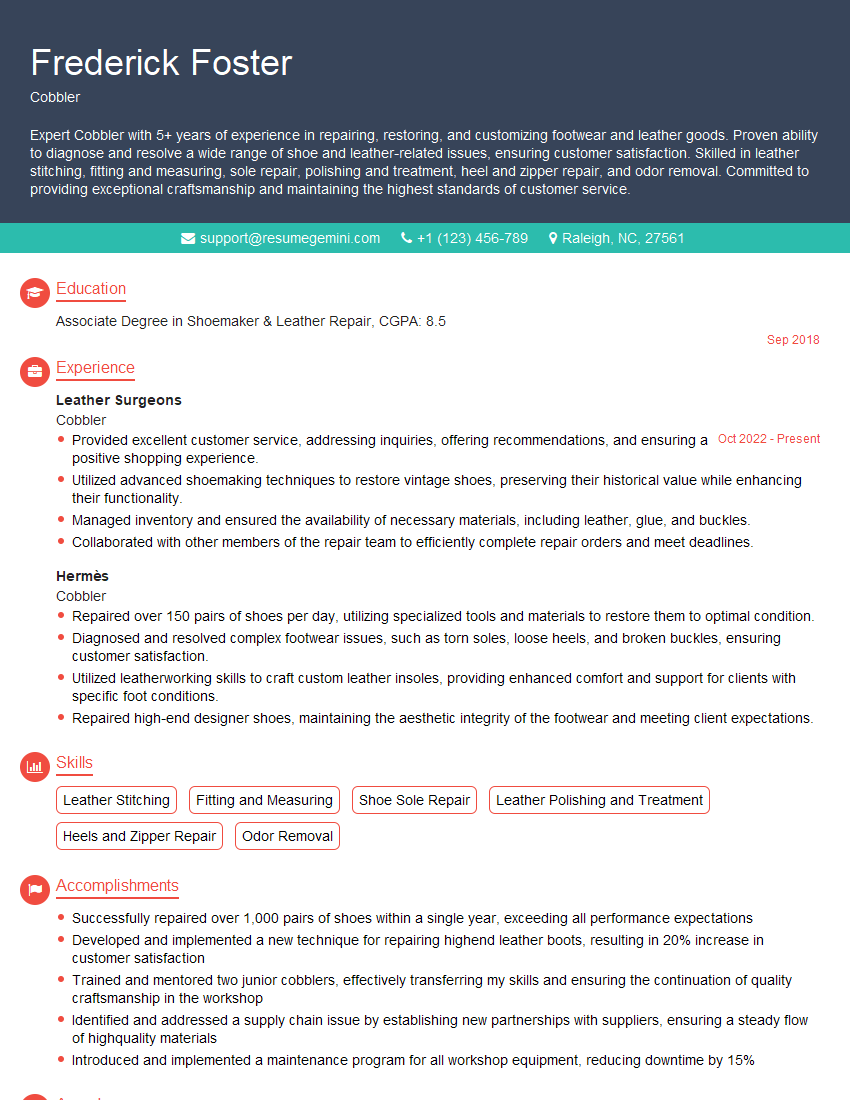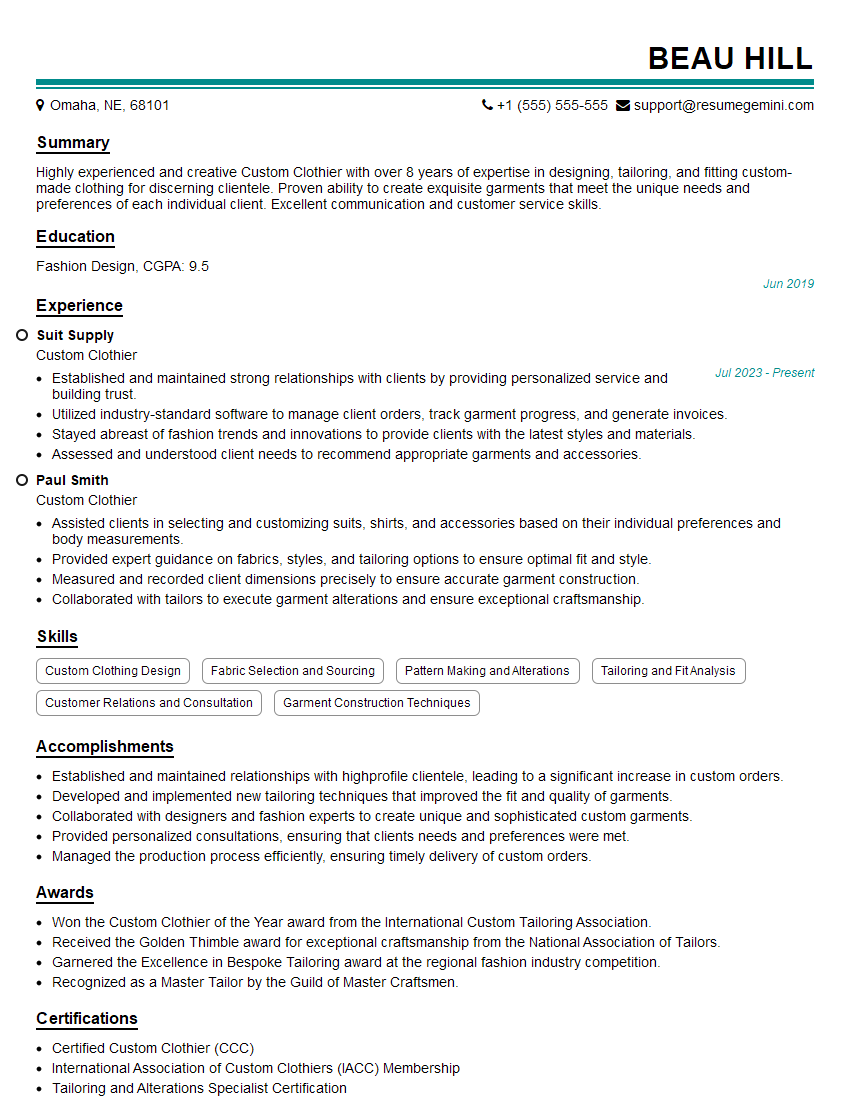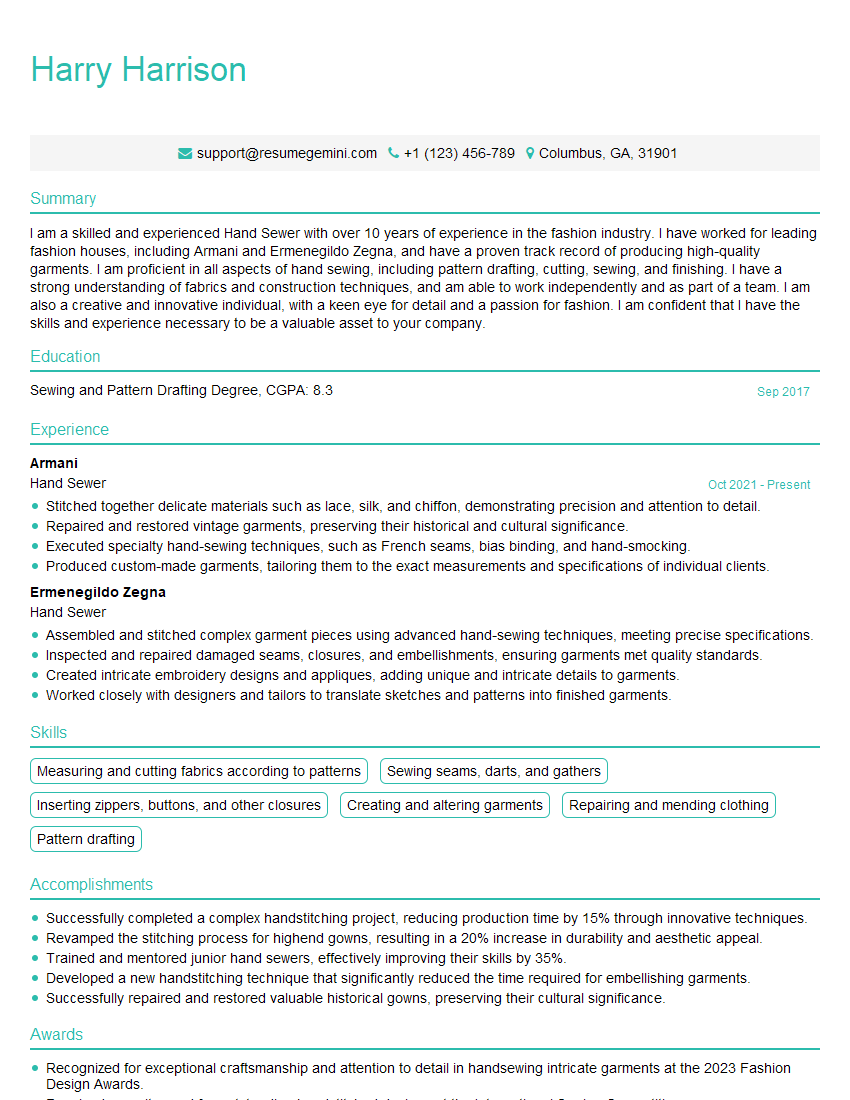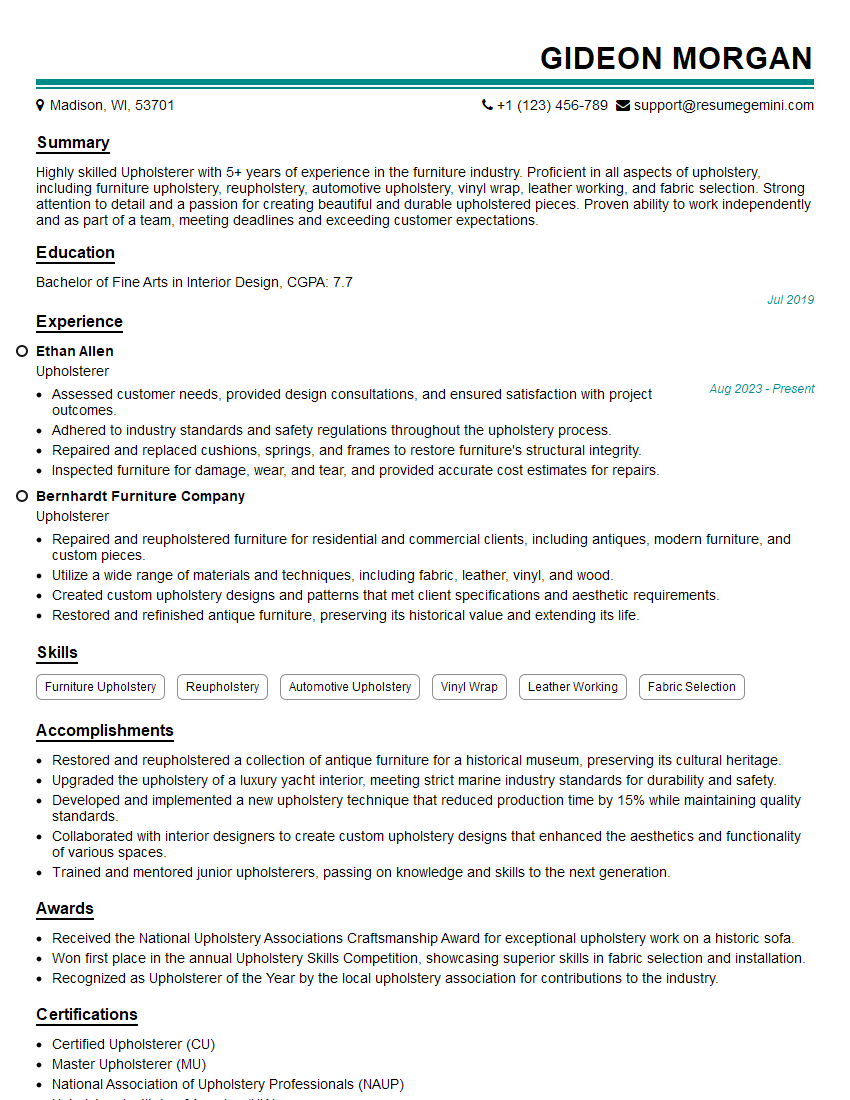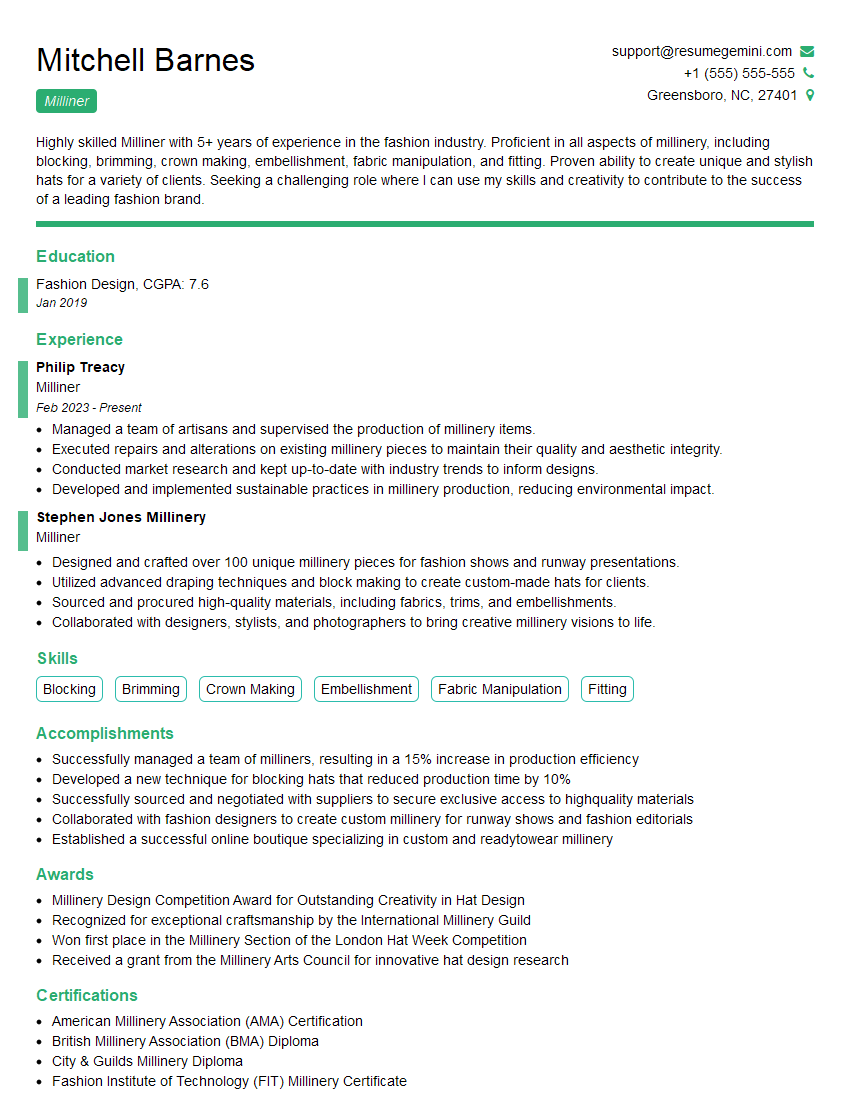Are you ready to stand out in your next interview? Understanding and preparing for Ability to use a variety of hand sewing techniques interview questions is a game-changer. In this blog, we’ve compiled key questions and expert advice to help you showcase your skills with confidence and precision. Let’s get started on your journey to acing the interview.
Questions Asked in Ability to use a variety of hand sewing techniques Interview
Q 1. What are the different types of hand stitches you are proficient in?
My proficiency in hand sewing encompasses a wide range of stitches, each serving a unique purpose. I’m adept at fundamental stitches like the running stitch (perfect for basting or gathering), backstitch (strong and durable for seams), slip stitch (invisible for neat finishes), and blanket stitch (decorative and functional for edges). Beyond these basics, I’m skilled in more advanced techniques such as French seams (for a clean, professional finish on sheer fabrics), ladder stitch (for seamlessly joining two pieces of fabric), and various embroidery stitches for embellishment. My experience extends to adapting stitches to different fabrics and project needs; for instance, I’d use a smaller running stitch for delicate silk and a larger backstitch for heavy canvas.
- Running Stitch: Quick and temporary, ideal for basting.
- Backstitch: Strong and secure, used for seams and repairs.
- Slip Stitch: Invisible, perfect for seam finishing.
- Blanket Stitch: Decorative and strengthens edges.
- French Seam: Encloses raw edges for a polished look.
Q 2. Explain the process of creating a French seam.
Creating a French seam is a superior method for finishing seams, especially on sheer or lightweight fabrics. It completely encloses raw edges, resulting in a very clean and professional finish. Here’s the process:
- First Seam: With wrong sides together, sew a 1/4-inch seam allowance. Trim the seam allowance to 1/8 inch. Press the seam open.
- Second Seam: Turn the fabric right side out. Fold the fabric so that the first seam allowance is nested inside. Sew a second seam 1/4 inch from the first seam, enclosing the raw edges within the second seam allowance. Press the seam toward the center.
Think of it like wrapping a tiny gift; the raw edges are completely hidden within the finished seam. This is particularly useful when working with silk or other fabrics where raw edges might fray easily or be visible.
Q 3. Describe your experience with various needle types and their applications.
My experience with needles is extensive, and choosing the right needle is critical for success. Sharps are versatile, ideal for general sewing. Betweens are excellent for medium-weight fabrics. Crewel needles, with their blunt points, are perfect for embroidery on fabric. For delicate fabrics like silk or chiffon, I’d use a fine, sharp needle to avoid damaging the material. Similarly, heavier fabrics like denim or canvas require a sturdier needle, potentially a jeans needle, with a stronger shaft to resist breakage.
I’ve learned to assess the fabric’s weight, weave, and fiber type before selecting a needle, ensuring smooth stitching and avoiding snags or breaks. For example, when sewing quilting cotton, I’d use a universal needle; but when tackling leather, I’d switch to a leather needle with a specialized triangular point to pierce the material effectively.
Q 4. How do you select the appropriate thread for different fabrics?
Thread selection is as crucial as needle choice. The thread’s weight, fiber content, and color should complement the fabric. For lightweight fabrics like silk, a fine thread like 60 wt. or 80 wt. is appropriate. Heavier fabrics, such as canvas or denim, need a heavier thread, such as 30 wt. or even a heavier upholstery thread. The fiber content of the thread should ideally match or complement the fabric’s fiber content to avoid undue friction or breakage. For example, cotton thread is great for cotton fabrics, while silk thread suits silk fabrics. Always consider color matching carefully—in some situations, a thread slightly darker or lighter than the fabric is preferable to ensure it’s not too prominent in the finished piece.
Q 5. What are the key considerations when working with delicate fabrics?
Working with delicate fabrics demands extra care and attention. Key considerations include using the appropriate needles (fine sharps or betweens), choosing fine thread that won’t overwhelm the fabric, and using a gentle touch while stitching. Basting is extremely important as it allows for accurate stitching and helps prevent stretching or distortion. Also, using a thimble to protect the fingers and using support materials like tissue paper underneath the fabric can aid in preventing pulls or snags. It is crucial to avoid overly aggressive movements and maintain a steady, consistent rhythm.
I often work with delicate fabrics, particularly for costume or dressmaking projects. For example, when working with silk chiffon, I use a tissue paper backing for extra support and a size 70/10 needle. This prevents tearing and helps ensure perfectly formed stitches.
Q 6. How do you prevent puckering when sewing curves?
Pucker is the enemy of beautiful curves! To prevent puckering when sewing curves, small, even stitches are paramount. Using smaller stitches than normal, especially along the curve’s most pronounced parts, helps maintain control. Easing the fabric gently as you stitch – adding small tucks to the outer curve while pulling the inner curve gently – is a valuable technique. Consider using a curved needle when stitching curves; it facilitates better control around the curves. Also, using a rotary cutter to cut the curves precisely reduces the likelihood of puckering from uneven fabric. Clipping the curves with small, precise snips after stitching can ease tension. When in doubt, always baste the curves first for a test run.
Q 7. Explain the importance of proper seam finishing techniques.
Proper seam finishing is essential for durability and a professional appearance. It prevents fraying, adds strength, and contributes significantly to the overall quality of the garment or project. Techniques such as serging (using an overlock stitch), zigzag stitching, pinking (using pinking shears), or using bias tape are all effective for preventing fraying and ensuring a clean finish. For more delicate fabrics, a French seam or a neat slip stitch can create a truly invisible and robust finish. The choice of seam finish depends on the fabric type, project requirements, and the desired aesthetic. Think of seam finishing as the foundation upon which your project stands; it’s the unsung hero of excellent craftsmanship.
For example, I’d never leave a seam in a client’s bespoke garment unfinished. Using the appropriate finishing technique is crucial for durability and overall professional quality. I’ve seen projects where poor seam finishing leads to unraveling, making the garment not only look shabby but also compromises its lifespan significantly. This illustrates the critical role of seam finishing.
Q 8. How do you adapt your hand sewing techniques for different fabric weights?
Adapting hand sewing techniques to different fabric weights is crucial for achieving a professional finish. Heavier fabrics, like denim or canvas, require stronger stitches and possibly different needles. Lighter fabrics, such as silk or chiffon, need finer needles and stitches to avoid puckering or damage.
- Heavy Fabrics: I’d use a larger needle (size 14-18) and a stronger thread, perhaps a heavier cotton or linen thread. Stitches like a backstitch or a running stitch would be reinforced for durability. I might also use a thimble for extra protection and control.
- Medium Fabrics: A medium-weight needle (size 11-14) and an all-purpose thread works well here. A simple running stitch or slip stitch would suffice.
- Light Fabrics: A very fine needle (size 7-10) and a fine silk or polyester thread is essential. A slip stitch or invisible stitch is preferred to keep the stitching nearly undetectable. Working on a smooth surface helps prevent pulling or stretching the delicate material.
For example, when mending a tear in a heavy wool coat, I’d employ a strong backstitch. Conversely, when creating a delicate French seam in silk, I’d use a tiny slip stitch to ensure an immaculate finish.
Q 9. Describe your experience with hand-sewing closures (buttons, zippers, hooks).
Hand-sewing closures demands precision and attention to detail. I’m proficient in attaching buttons using various techniques, including shank buttons (where I create a small loop to prevent the button from lying flat against the fabric), and standard buttons (sewn directly to the fabric with x’s or a buttonhole stitch).
With zippers, I can hand-sew both invisible and visible zippers, carefully aligning the zipper teeth with the fabric edge and using a slipstitch to conceal the stitching. Hooks and eyes are also straightforward; I use a small, strong stitch to secure them firmly to the garment, ensuring a secure closure.
I once had to hand-sew invisible zippers onto a delicate silk dress, a challenge requiring meticulous attention to detail and the use of fine thread and a tiny needle. The end result was a beautifully finished garment, showcasing my ability to adapt techniques to different material.
Q 10. How do you repair a ripped seam using hand sewing?
Repairing a ripped seam begins with careful preparation. First, I’d press the seam open to assess the damage. Then, I’d hand-sew the rip closed using a backstitch or ladder stitch, depending on the fabric weight and seam type. For a ladder stitch, I would weave the needle in and out of each rung, mimicking the existing seam. For a backstitch, I would create a strong, durable seam by overlapping stitches.
Step-by-step example using backstitch for a heavier fabric:
- Pin the ripped edges together, aligning the seam as accurately as possible.
- Start sewing about 1/4 inch from the end of the rip with a backstitch, taking small, even stitches.
- Continue stitching along the rip, overlapping each stitch with the previous one to create a sturdy seam.
- Finish the stitching, securing the thread securely.
- Press the seam flat to neaten it.
The choice of stitch depends on the fabric and the visibility of the repair. A ladder stitch provides a less visible repair, ideal for fine fabrics, whereas a backstitch is stronger and better for more robust materials.
Q 11. What are the advantages and disadvantages of different hand-sewing methods?
Various hand-sewing methods offer different advantages and disadvantages:
- Running stitch: Advantages: Fast, simple, good for gathering. Disadvantages: Not very strong, visible.
- Backstitch: Advantages: Strong, durable, good for seams. Disadvantages: Time-consuming, visible.
- Slip stitch: Advantages: Invisible, neat, good for finishing seams. Disadvantages: More challenging for beginners.
- Blanket stitch: Advantages: Decorative, strong, good for blankets and edges. Disadvantages: Time-consuming.
For instance, I might use a running stitch for quickly basting fabric pieces together, but a backstitch for creating a sturdy seam on a pair of trousers. The slip stitch would be my go-to for neatly closing a seam on a delicate blouse. The choice is dictated by the project’s requirements and desired aesthetic.
Q 12. Describe your experience working with different types of sewing patterns.
My experience with sewing patterns spans a wide range of styles and complexities. I’m comfortable working with both commercial and independently drafted patterns, from simple garments like skirts and tops to more intricate pieces such as jackets and dresses. I’m adept at understanding pattern markings, such as notches, grainlines, and seam allowances, and can adjust patterns to accommodate individual measurements or design preferences.
For example, I’ve worked with vintage patterns that required careful adjustments to fit modern sizing, and I’ve also created custom patterns from scratch for projects requiring unique shapes or sizes. I always carefully read through the instructions and plan each step thoroughly before starting to sew.
Q 13. How do you measure fabric accurately for hand sewing projects?
Accurate fabric measurement is paramount in hand sewing. I always use a flexible measuring tape, ensuring it lies flat against the fabric without stretching or distorting it. For straight measurements, I’ll pull the fabric taut to avoid bias and use a ruler or other straight edge to help guide the tape measure.
When cutting fabric, I add seam allowances to my measurements, carefully noting the pattern’s instructions. I prefer using sharp fabric shears to ensure clean cuts. For curved or intricate shapes, I utilize pattern weights to keep the pattern from shifting during cutting, and I double-check the measurements several times to guarantee accuracy.
Q 14. Explain your experience with creating and using sewing patterns.
Creating and using sewing patterns is a core skill. I’ve drafted patterns using both the draping method (where I manipulate fabric directly on a dress form to create the pattern) and the flat-pattern method (where I work from existing measurements and calculations on paper). Both methods require a strong understanding of garment construction and precise measurements.
I often adapt existing patterns for personal needs, making changes to the design or fit. This requires a good eye for detail and the ability to visualize the effect of changes on the final product. I meticulously document my pattern adjustments to ensure consistency and to facilitate future projects. This experience has allowed me to design and produce numerous unique pieces, from custom-fit dresses to tailored coats.
Q 15. How do you handle fabric that is prone to fraying?
Dealing with fraying fabric is crucial for any hand-sewing project. The key is to prevent the unraveling before it starts, and then to reinforce the edges to maintain a clean finish.
- Pre-emptive Measures: Before cutting, I always use pinking shears to create a zig-zag edge that minimizes fraying. This is especially important for lightweight or loosely woven fabrics like chiffon or linen. Alternatively, I can use a serger, if available, for a professional-grade finish.
- Finishing Techniques: For edges that need a neater appearance, I utilize techniques like French seams (for delicate fabrics), zigzag stitching (a quick and easy solution), or bias binding (for a clean, crisp finish, particularly for seams or hems). The choice depends on the fabric type and the overall project aesthetic. For example, a French seam is perfect for a high-end garment, while zigzag stitching works well for a simple tote bag.
- Specific Fabric Considerations: Some fabrics are more prone to fraying than others. For very delicate materials, I might consider using a temporary adhesive like a fabric glue stick to hold the edges in place while I sew.
For instance, while creating a silk scarf, using a French seam not only prevents fraying but also adds a touch of elegance. Using pinking shears on a cotton tote bag keeps things simple and effective.
Career Expert Tips:
- Ace those interviews! Prepare effectively by reviewing the Top 50 Most Common Interview Questions on ResumeGemini.
- Navigate your job search with confidence! Explore a wide range of Career Tips on ResumeGemini. Learn about common challenges and recommendations to overcome them.
- Craft the perfect resume! Master the Art of Resume Writing with ResumeGemini’s guide. Showcase your unique qualifications and achievements effectively.
- Don’t miss out on holiday savings! Build your dream resume with ResumeGemini’s ATS optimized templates.
Q 16. Describe your problem-solving skills when encountering difficulties during hand sewing.
Problem-solving is an inherent part of hand sewing. I approach challenges systematically, breaking down the issue into smaller, manageable steps.
- Identify the Problem: First, I pinpoint the exact issue. Is the seam puckering? Is the needle breaking? Is the tension off? Accurate diagnosis is crucial.
- Analyze and Research: Once identified, I analyze the cause. I might refer to reference books, online tutorials, or consult experienced colleagues if needed. Sometimes, a quick online search yields surprising solutions.
- Implement Solutions: Based on my analysis, I implement solutions. This might involve adjusting needle size, thread tension, using different stitches, or even re-evaluating the pattern. I always start with the simplest solutions first, before moving to more complex ones.
- Document and Learn: Finally, I document the issue and the solution I employed. This helps prevent similar problems in the future. Every challenge presents a learning opportunity, refining my skills and approaches.
For example, once I encountered a persistent puckering issue while sewing a curved seam. After checking thread tension and needle size, I realized the pattern piece was slightly off. Adjusting the pattern resolved the problem, highlighting the importance of thorough pattern checking.
Q 17. What are the safety precautions you take while hand sewing?
Safety is paramount in any sewing practice. I always prioritize safety through these measures:
- Sharp Needle Handling: I never leave needles unattended and always use a needle minder or a designated pincushion. I never sew with a bent needle, as it increases the risk of breakage and injury. I also pay close attention to my needle selection, choosing appropriately sized needles for each fabric.
- Proper Lighting: Adequate lighting prevents eye strain and ensures accurate stitching, reducing the risk of accidental needle pricks.
- Comfortable Posture: Maintaining proper posture prevents back and neck strain, ensuring a safe and comfortable sewing experience. I use ergonomic tools whenever possible.
- First Aid: I always have a well-stocked first-aid kit within easy reach to address any minor injuries that might occur.
Think of it like this: treating your sewing space like a well-organized and safe laboratory ensures smooth and mishap-free operations.
Q 18. How do you maintain your hand-sewing tools and equipment?
Maintaining my tools is essential for quality work and longevity. I follow these practices:
- Needle Storage: Needles are stored in a magnetic needle keeper to prevent loss and protect them from damage.
- Thread Management: I store threads in organized containers to avoid tangles and maintain quality. Thread spools should be stored in a cool, dry place to preserve thread quality.
- Scissor Sharpening: I regularly sharpen my sewing scissors using a sharpening stone to maintain their sharpness and efficiency. Dull scissors can damage fabric and strain your hands.
- Cleaning: After each project, I clean my sewing machine (if applicable) and hand-sewing tools, removing lint and debris to keep them functioning optimally. This also prevents rust and extends the life of my tools.
Regular maintenance equates to a smooth sewing process and ensures the quality and longevity of my work and equipment.
Q 19. How do you ensure consistency and accuracy in your hand-sewing work?
Consistency and accuracy are achieved through a combination of techniques and mindful practice:
- Consistent Stitching: I practice maintaining even stitch length and tension throughout my projects. Using a thimble helps ensure consistent pressure.
- Precise Measuring: I always measure precisely, using a ruler or measuring tape, before cutting and sewing to ensure accuracy. Using pattern markings effectively is also crucial.
- Proper Preparation: I meticulously prepare my fabric, pressing seams and ensuring accurate pattern placement before beginning to sew.
- Reference Points: I utilize markings and guides on patterns, ensuring consistent placement and alignment of fabric pieces.
Think of it like baking a cake: precise measurements and consistent technique are critical to the final product. Consistent hand-sewing practice enhances accuracy and results in a cleaner and more professional finish.
Q 20. Describe your experience with hand-sewing embellishments (e.g., embroidery, beading).
I have extensive experience with hand-sewing embellishments, including embroidery and beading. Both techniques add unique texture and visual interest to projects.
- Embroidery: I’m proficient in various embroidery stitches, including satin stitch, cross-stitch, French knots, and running stitch, each creating a unique effect. I understand color theory and its application in embroidery designs to create visually appealing pieces.
- Beading: My beading skills encompass various techniques, including seed beading, adding larger beads for emphasis, and using different beading needles and threads based on the project’s requirements. Understanding how to securely attach beads without damaging the fabric is vital.
- Combining Techniques: I frequently combine embroidery and beading to create more intricate and dimensional embellishments. For example, I might embroider a floral design and then add beads to create highlights and texture.
I recently completed a bespoke bridal gown that incorporated intricate hand-embroidered floral patterns accented with delicate pearl beading. This showcased both my technical skills and my artistic flair.
Q 21. How do you assess the quality of your hand-sewing work?
Assessing the quality of my hand-sewing work involves a multi-faceted approach, focusing on both technical aspects and aesthetic elements:
- Stitch Consistency: I examine stitch length, tension, and uniformity. Consistent stitching is a hallmark of high-quality work.
- Seam Finish: I evaluate the neatness of seams, checking for fraying, puckering, or uneven edges. A well-finished seam is both functional and aesthetically pleasing.
- Accuracy: I review the accuracy of the project in relation to the pattern or design, checking for precise alignment and measurements. Accurate stitching results in a well-fitting and well-proportioned final product.
- Overall Appearance: I consider the overall appearance, looking for any imperfections such as loose threads or visible stitching flaws. I critically evaluate the final aesthetic outcome against my expectations.
It’s like critiquing a painting; technical skill is important, but the final impression created by the piece is essential.
Q 22. What are some common mistakes to avoid when hand sewing?
Avoiding common hand-sewing mistakes is crucial for achieving professional results. Many issues stem from inadequate preparation or poor technique. Here are some key areas to focus on:
Uneven stitches: Consistent stitch length and tension are paramount. Practice maintaining a steady rhythm and consistent pressure on the needle. Think of it like writing – a consistent hand produces legible script.
Skipped stitches or holes: Pay close attention to each stitch to ensure complete penetration of the fabric. Using a thimble can help prevent accidental needle pricks and maintain consistent pressure.
Knotting or tangling thread: Keep your thread supply organized and avoid unnecessary tension on the thread. Regularly check for knots and gently untangle them before they become problematic. Imagine a fishing line – a knot can easily ruin the whole line.
Incorrect needle selection: Choose the appropriate needle size for your fabric and thread weight. Too small a needle will cause breakage, too large will create unsightly holes. Consider the needle as a tool – the right one will make the job easier.
Poor fabric preparation: Pre-wash fabrics to prevent shrinkage after sewing. Pressing seams before sewing helps create a smoother finish and prevents puckering.
Q 23. How do you adapt your techniques when working with different types of threads?
Adapting techniques to different threads requires understanding their properties. For example:
Fine threads (e.g., silk, embroidery floss): Require finer needles and a lighter touch to prevent breakage. Smaller stitches are generally used for a more delicate appearance.
Heavy threads (e.g., heavy-duty cotton, waxed linen): Need stronger needles and may require a larger stitch to prevent the thread from bunching or breaking. These are great for durability, such as in canvas bags.
Synthetic threads (e.g., polyester, nylon): Often have greater tensile strength but can be slippery. Using a knotting technique that ensures a secure fastening is crucial. These threads might require a slightly sharper needle.
Natural threads (e.g., cotton, linen): Can vary in strength and texture. Pre-testing on a scrap of fabric is helpful to assess the needed needle size and stitch length.
In all cases, consider the fabric being sewn as well. A delicate fabric will demand a finer thread regardless of its strength. The balance between thread, needle, and fabric is key to success.
Q 24. Describe your experience with appliqué and its various techniques.
Appliqué is a wonderful technique for adding decorative elements to fabric. My experience spans various methods:
Needle-turn appliqué: This method involves precisely stitching around the edges of the appliqué fabric, creating a neat, almost invisible seam. I’ve used this extensively for fine detail work on quilts and clothing.
Blind appliqué: The edges of the appliqué are stitched down from the back, creating a completely hidden seam. This is perfect for clean, modern designs.
Raw-edge appliqué: This technique utilizes fabrics that don’t fray easily, and the edges are left unfinished, adding a rustic charm. I’ve incorporated this in many craft projects, offering a simpler, quicker method.
Embroidery appliqué: The appliqué pieces are secured with decorative stitches, making them part of the overall embroidered design. This allows for a unique blend of techniques and textures.
Each technique requires a different approach to stitching and fabric selection, demanding precision and attention to detail to achieve the desired look.
Q 25. How do you achieve a professional finish in your hand-sewing projects?
Achieving a professional finish in hand sewing involves meticulous attention to detail throughout the entire process. Here are key elements:
Consistent stitch length and tension: This creates a uniform and neat appearance.
Secure knots: Use multiple knots to prevent unraveling. Practice different knotting techniques to find the most reliable for different threads.
Neat seam finishes: Consider techniques like overcasting or pinking to prevent fraying.
Pressing: Pressing seams open or to one side helps create crisp, professional-looking garments or projects.
Hidden seams: Where appropriate, seams should be neatly tucked away for a clean finish.
Careful thread selection: Matching thread to the fabric in color and weight adds to the overall quality.
Think of it as a painting – every brushstroke counts. Attention to the small details builds to the final masterpiece.
Q 26. Explain your approach to quality control in hand sewing.
Quality control in hand sewing is an ongoing process, not just a final check. My approach includes:
Pre-sewing checks: Carefully inspect fabrics for flaws, pre-wash to prevent shrinkage, and ensure accurate cutting.
Regular stitch checks: While sewing, regularly assess the consistency of stitch length, tension, and overall neatness.
Seam evaluation: Examine seams for strength, security, and any imperfections. Reinforce weak areas as needed.
Final inspection: A thorough final check for any loose threads, skipped stitches, or other imperfections. This includes a final pressing.
Self-critique: Reflecting on my work helps identify areas for improvement, enhancing my skill over time.
It’s about building in checks at every stage to ensure high standards are maintained.
Q 27. How do you handle large or complex hand-sewing projects?
Large or complex hand-sewing projects require a strategic approach. I typically follow these steps:
Detailed planning: Thorough pattern review, fabric selection, and a detailed plan of attack, breaking down the project into manageable sections.
Preparation: Cutting out fabric pieces accurately, preparing the necessary tools and threads.
Step-by-step execution: Focus on completing one section at a time, ensuring quality at each stage before moving on. This avoids feeling overwhelmed.
Regular breaks: Prevents fatigue and maintains focus, improving accuracy.
Intermediate checks: Regularly check for consistency, accuracy, and any issues that need addressing. This is like working on a large puzzle, one piece at a time.
Breaking down the task into smaller, more manageable pieces and regularly checking progress is crucial for successful completion.
Q 28. How do you stay up-to-date with the latest hand-sewing techniques and trends?
Staying current in the hand-sewing world is vital. I achieve this through:
Workshops and classes: Attending workshops and classes offered by experienced sewists expands my skills and exposes me to new techniques.
Books and magazines: Reading dedicated sewing books and magazines provides inspiration and knowledge on new trends and techniques.
Online resources: Following sewing blogs, online forums, and watching tutorials on platforms like YouTube broadens my understanding of the field.
Networking: Connecting with other hand-sewists, sharing experiences and learning from their expertise.
Experimentation: Regularly trying new techniques and materials allows for personal growth and development.
Continuous learning and exploration are essential for staying at the forefront of the craft.
Key Topics to Learn for Ability to use a variety of hand sewing techniques Interview
- Basic Stitches: Mastering running stitch, backstitch, slip stitch, blanket stitch, and whip stitch. Understand their applications and when each is most appropriate.
- Seam Construction: Learn how to create different types of seams (French seams, flat felled seams, etc.) and their strengths and weaknesses. Discuss the impact of seam allowance and finish on garment durability.
- Fabric Selection & Handling: Demonstrate knowledge of various fabric types (silk, cotton, linen, etc.) and how different fabrics require different needle and thread choices and sewing techniques.
- Mending & Repair Techniques: Explain your proficiency in patching, darning, and repairing tears or holes in various fabrics. Be ready to discuss different approaches for different fabric types and damage.
- Hand Sewing Tools & Equipment: Discuss your familiarity with needles, threads, thimbles, scissors, seam rippers, and other relevant tools. Explain how tool selection impacts the quality of your work.
- Finishing Techniques: Demonstrate knowledge of techniques like hand-finishing seams, creating clean edges, and applying different types of bindings or facing.
- Problem-Solving & Adaptability: Be prepared to discuss how you approach challenges like broken needles, difficult fabrics, or unexpected alterations during a hand-sewing project.
Next Steps
Mastering a variety of hand sewing techniques is invaluable for many roles, showcasing meticulous attention to detail, problem-solving skills, and practical dexterity. This skillset translates to success in various creative and technical fields. To maximize your job prospects, create a strong, ATS-friendly resume that highlights your abilities effectively. ResumeGemini is a trusted resource to help you build a professional resume that showcases your skills and experience in the best possible light. Examples of resumes tailored to showcasing expertise in hand sewing techniques are available within ResumeGemini to help guide you.
Explore more articles
Users Rating of Our Blogs
Share Your Experience
We value your feedback! Please rate our content and share your thoughts (optional).
What Readers Say About Our Blog
Hello,
We found issues with your domain’s email setup that may be sending your messages to spam or blocking them completely. InboxShield Mini shows you how to fix it in minutes — no tech skills required.
Scan your domain now for details: https://inboxshield-mini.com/
— Adam @ InboxShield Mini
Reply STOP to unsubscribe
Hi, are you owner of interviewgemini.com? What if I told you I could help you find extra time in your schedule, reconnect with leads you didn’t even realize you missed, and bring in more “I want to work with you” conversations, without increasing your ad spend or hiring a full-time employee?
All with a flexible, budget-friendly service that could easily pay for itself. Sounds good?
Would it be nice to jump on a quick 10-minute call so I can show you exactly how we make this work?
Best,
Hapei
Marketing Director
Hey, I know you’re the owner of interviewgemini.com. I’ll be quick.
Fundraising for your business is tough and time-consuming. We make it easier by guaranteeing two private investor meetings each month, for six months. No demos, no pitch events – just direct introductions to active investors matched to your startup.
If youR17;re raising, this could help you build real momentum. Want me to send more info?
Hi, I represent an SEO company that specialises in getting you AI citations and higher rankings on Google. I’d like to offer you a 100% free SEO audit for your website. Would you be interested?
Hi, I represent an SEO company that specialises in getting you AI citations and higher rankings on Google. I’d like to offer you a 100% free SEO audit for your website. Would you be interested?
good
